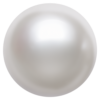
Rich in ancient history and lore, pearls are among the world’s most-coveted gemstones. Unlike other gems, pearls are the products of living animals. Whether cultured or naturally produced, all pearls begin their formation in animals living deep within the world’s lakes, rivers, and seas.
Pearl Types

Freshwater Pearls
ORIGIN: Bodies of freshwater in China
MUSSEL: Hyriopsis cumingii, Hyriopsis schlegelii
SIZE RANGE: 4mm-15mm
NATURAL COLORS: White, Cream, Pink, Peach, Apricot, Lavender
KNOWN FOR: Value for the price. Diverse colors, shapes, and sizes
Freshwater pearl culturing dates back to 13th century China, with the production of blister pearls. By the 1930s, Freshwater pearl production began to thrive in Japan. It wasn’t until the 1960s that China’s production began to rival Japan’s.
Today, China is undisputedly lead producer of Freshwater pearls, with 90% and more of the world’s Freshwater pearls being from China. Due to the nature of their culturing, up to 36-38 pearls can be harvested from one Freshwater mussel. Being the largest pearl crop in the world, they are also the most diverse of all the pearl types in size, shape, and color. Unlike other pearl types, Freshwater pearls are also the only pearls that are almost entirely composed of nacre, making them durable and resistant to wear and tear.
In the past, Chinese perliculturists were restricted to implanting freshwater pearl mussels with small pieces of mantle tissue, limiting both the size of the Freshwater pearl and the shape. However, today’s pearl farmers are more innovative and skillful than ever before. Freshwater pearls are now implanted with a bead nuclei, similar to Tahitian and South Sea pearls. This new cultivation process has resulted in more round and much larger Freshwater pearls, reaching up to 10-15mm in size.

South Sea Pearls
ORIGIN: Australia, Philippines
OYSTER: Silver or Golden Lipped Pearl Oyster, Pinctada maxima
SIZE RANGE: 8mm-20mm
NATURAL COLORS: White-Silver and Gold
KNOWN FOR: Rarity, Opulent colors and large size
The first attempts to culture South Sea pearls were made in the 1890s and it wasn’t until the 1950s-60s that they were able to be cultured on a commercial level. Because these oysters have not been able to thrive outside their native waters, the culturing areas are extremely limited. In addition, the large size of the pearl requires a longer growth time than other pearls, putting them at higher risk for damage from disease, pollution, and weather. Today, South Sea pearls are the most rare and valuable of all pearl types.
There are 2 types of Pinctada maxima oysters – the Silver Lipped and Golden Lipped Pearl Oysters. While the Silver Lipped oyster generally produces white and silver pearls and the Golden Lipped oyster produces golden shades of pearls, both types can produce either range of hues.
Like the other saltwater pearl types, South Sea pearls are implanted with a round shell bead to help ensure round pearls, and only 1-2 pearls can be harvested from each oyster. Similar to the Black Lipped oyster that produces Tahitian pearls, the P. maxima can also be re-nucleated up to 2 additional times producing larger pearls each time. The silvery white and golden hues are unique to the South Sea pearls, as is their thick nacre and rich, satiny luster. The warm waters of the South Seas cause the pearl’s nacre to build up faster and thicker than the other pearl types. This makes the crystals of the nacre more spread out, and therefore, less sharp and reflective.

Akoya Cultured Pearls
ORIGIN: Saltwater’s in Japan and China
OYSTER: Akoya Pearl Oyster, Pinctada fucata
SIZE RANGE: 3mm-10mm
NATURAL COLORS: White-Ivory, Rosé pink color overtones
KNOWN FOR: Mirror-like Luster, Pink-Rosé Hues
The epitome of the classic pearl, Akoya pearls were the first to be successfully cultured. Akoya pearl culturing began in Japan in the early 1900s. They dominated the pearl culturing industry for so much of the century that “cultured pearls” became synonymous with Japanese Akoya pearls. It wasn’t until the 60s that China started culturing pearls, and it wasn’t until the 80s that their Akoya pearls even came close to the quality of the Japanese pearls.
Like the other saltwater pearls, Akoya pearls are cultured by implanting a round shell bead into the oyster. This helps control the end pearl shape to its most desired, perfectly round shape. The Akoya oyster only harvests 1-2 pearls per oyster and has the smallest pearl size range. Any Akoya pearl over 8mm is increasingly rare and valuable.
Cherished for their mirror-like lustrous surface, round shape, and rich rosé color overtones, Akoya pearls remain the world’s most sought after and beloved pearl type.

Tahitian Black Pearls
ORIGIN: Islands of French Polynesia
OYSTER: Black Lipped Pearl Oyster, Pinctada margaritifera
SIZE RANGE: 8mm – 18mm
NATURAL COLORS: Range of dark hues
KNOWN FOR: Exotic Peacock Color
For hundreds of years, the Black Lipped Pearl Oyster was harvested by the natives of the French Polynesia area for its meat and beautiful, Mother-of-Pearl shell. By chance, natural dark pearls were occasionally found inside. The rarity of these pearls caused them to be nick-named, “The Queen of Pearls and the Pearl of Queens,” as it was only royalty that was able to afford these naturally-occurring dark pearls.
It wasn’t until the mid-1960s that Tahitian pearls started being cultured, using Japanese culturing techniques. Due to the widespread disbelief of cultured black pearls, it wasn’t until the late 70s and early 80s that they became sought after in the market. Tahitian pearls’ popularity soared for their large size and natural dark body color. Today, their popularity continues with Tahitian pearls accounting over 50% of French Polynesia’s exports.
Like the Akoya oyster, the Black Lipped oyster is only able to produce 1-2 pearls per oyster, though after harvest each oyster can be re-nucleated up to 2 additional times subsequently producing larger pearls. The sensitive oyster has failed numerous attempts at being cultured outside their native waters, making the culturing process expensive and limited. Though prized for being the only naturally dark pearls, Tahitians are rarely ever a true black. Instead, Tahitians are most often found in a gray body color with greenish overtones, but can occur in virtually every color of the rainbow.


